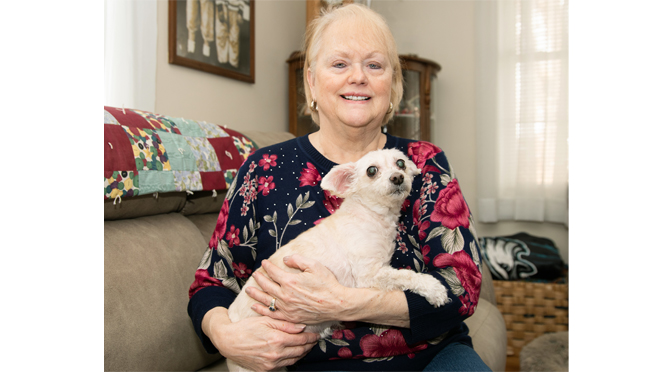Cathy Rogers fondly remembers back to her days participating in the annual March of Dimes Walk.
“I used to walk 16 miles in that,” she said. “I used to walk everywhere. And then, it seems like just one day, I started feeling very tired, very short of breath until, just a few years back, I couldn’t even walk a block. That’s when all the physicians came into play.”
Cathy, who lived in Florida for more than 30 years but moved back to the Lehigh Valley to help care for her mother in Fountain Hill, soon found out she was the one in need of care, the kind of extraordinary heart care found at St. Luke’s University Network, the region’s leader in heart care and one of the PINC AI Top 50 Cardiovascular Hospitals in the country.
St. Luke’s cardiologists and cardiothoracic surgeons worked as a team and utilized St. Luke’s cut-last philosophy until no other option existed except open-heat surgery, and today Cathy is thriving with newfound energy.
Yulia Aleksandrova, MD, Cathy’s primary care physician, performed a routine examination and immediately referred her to interventional cardiologist Luis Tejada, MD, who then referred her to thoracic and cardiac surgeon J.R. Fitzpatrick, MD, to rule out a mitral valve issue.
Finally, she was diagnosed with obstructive hypertrophic cardiomyopathy (HCM), an enlargement and thickening of the left ventricle that restricts normal blood flow to the aorta, and referred to cardiologist Jamshid Shirani, MD, who initially placed her on a beta blocker, the first line of treatment.
“Eventually her symptoms were not responding to medical treatment,” Dr. Shirani said, “and Cathy underwent a procedure called alcohol septal ablation, which is a catheter procedure where they place a catheter into the arteries of the heart that supply the thickest part of the ventricle and inject it with absolute alcohol to basically shrink that extra piece of muscle that blocks the flow of blood out of the ventricle.”
The initial improvement from that procedure disappeared, and Cathy was placed into a treatment plan with a newly approved drug called mavacamten, but even that did not produce the desired results.
Last August, Cathy underwent open heart surgery by thoracic and cardiac surgeon Stephen Olenchock, DO. He performed a septal myectomy, removing a small portion of the septum – the inner wall between the left and white ventricles which had thickened – to restore the flow of blood from the ventricle to the aorta.
“I was devastated,” she said of the news that she would need to undergo open-heart surgery. “You hear open-heart surgery, and you always get panicky, but Dr. Olenchock was very thorough and told me what was going to happen, and he told me he would make sure nothing bad happened to me. He alleviated my fears.”
It has given her a new lease on life. Cathy turned 70 last December, and still works full time as a transcriptionist – remotely – for the dermatologist she worked for back in Florida.
“I went to cardiac rehab for a few weeks and now I’m exercising at home about 150 minutes a week, which they recommend,” Cathy said. “We have a small gym in our home with a recumbent bike, a treadmill and a stair-climbing machine, and I switch between those and go for walks with my other half. I’ve lost almost 10 pounds and I’m happy!”
Her newfound return to activity is typical for patients who are finally freed from HCM.
“This condition produces so many symptoms that can be subtle, so the first thing that often happens is patients slowly reduce their activity to match their symptoms,” Dr. Shirani explained. “They don’t realize how limited they are in the scope of their daily activities. After treatment works, they find new life and they can do things they thought were no longer possible.”
Cathy’s energy levels have lifted her to new heights, and allow her to enjoy camping once again, one of her favorite activities.
“Dr. Shirani is a wonderful, wonderful doctor and he will be my cardiologist for life,” she said. “My care from everyone at St. Luke’s was nothing short of amazing.”
About St. Luke’s
Founded in 1872, St. Luke’s University Health Network (SLUHN) is a fully integrated, regional, non-profit network of more than 20,000 employees providing services at 15 campuses and 300+ outpatient sites. With annual net revenue of $3.4 billion, the Network’s service area includes 11 counties in two states: Lehigh, Northampton, Berks, Bucks, Carbon, Montgomery, Monroe, Schuylkill and Luzerne counties in Pennsylvania and Warren and Hunterdon counties in New Jersey. St. Luke’s hospitals operate the largest network of trauma centers in Pennsylvania, with the Bethlehem Campus being home to St. Luke’s Children’s Hospital.
Dedicated to advancing medical education, St. Luke’s is the preeminent teaching hospital in central-eastern Pennsylvania. In partnership with Temple University, the Network established the Lehigh Valley’s first and only four-year medical school campus. It also operates the nation’s longest continuously operating School of Nursing, established in 1884, and 45 fully accredited graduate medical educational programs with more than 400 residents and fellows. In 2022, St. Luke’s, a member of the Children’s Hospital Association, opened the Lehigh Valley’s first and only free-standing facility dedicated entirely to kids.
SLUHN is the only Lehigh Valley-based health care system to earn Medicare’s five-star ratings (the highest) for quality, efficiency and patient satisfaction. It is both a Leapfrog Group and Healthgrades Top Hospital and a Newsweek World’s Best Hospital. The Network’s flagship University Hospital has earned the 100 Top Major Teaching Hospital designation from Fortune/PINC AI 11 times total and eight years in a row, including in 2023 when it was identified as THE #4 TEACHING HOSPITAL IN THE COUNTRY. In 2021, St. Luke’s was identified as one of the 15 Top Health Systems nationally. Utilizing the Epic electronic medical record (EMR) system for both inpatient and outpatient services, the Network is a multi-year recipient of the Most Wired award recognizing the breadth of the SLUHN’s information technology applications such as telehealth, online scheduling and online pricing information. The Network is also recognized as one of the state’s lowest cost providers.
Information provided to TVL by:
Sam Kennedy




